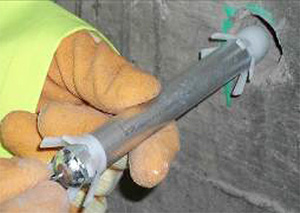CASE STUDY
BIRMINGHAM NEW STREET GATEWAY PROJECT
Document Type: Case Study
Document No: CN12-XO2-CS031
Author: Richard Edwards
Revision: 0
Revision Date: 24th June 2013
Type of Structure Reinforced Concrete
Client Network Rail
Treatment Types Hybrid Anode Cathodic Protection
Project Value £500,000
Project Duraction November 2012 to April 2013
Birmingham New Street railway station is the largest station outside of London and one of the largest interchanges in the UK. With passenger numbers now more than double that initially envisaged and with the station and Pallasades Shopping Centre [situated directly above the station] now showing significant signs of deterioration, Network Rail in association with Birmingham City Council, Advantage West Midlands, Centro and the Department for Transport undertook to redevelop the station to a new modern hub with the capacity to handle up to 250,000 passengers each day.
Conceptual view of the refurbished New Street Station.

MACE, the principal contractor for the works, were tasked with the transformation of the station, part of which entailed the refurbishment and restructuring of an adjacent car parking structure to fall within the final footprint of the new station.
Upon inspection of the reinforced concrete structure it was determined that the deck slabs, spine and secondary beams were heavily chloride contaminated and would require significant repair and rehabilitation to achieve the clients required design life.
Proposals were presented for the demolition of the structure and construction of a new steel framed structure on the site. Due to the sites proximity in relation to the active platforms of New Street Station and its location in the busy city centre demolition was not a viable option.
Instead an extensive repair scheme was developed which included removal and replacement of the suspended deck slabs and the installation of a cathodic protection system for the spine and secondary beams.
The site at the commencement of the works.

The new mixed use structure was to be utilised by the station, as a taxi drop off area, and as an area to house services for the planned John Lewis store which would ultimately form the centre piece of the station.
The clients’ requirements for an extended service life [circa 25 years] meant that short term solutions such as standard concrete repairs [5 years] and traditional galvanic anodes [10 years] would not be suitable. Migrating Corrosion Inhibitors [MCI] would not be suitable due to the high chloride content and proven long term repair solutions such as impressed current cathodic protection were not likely to be viable due to the requirement for regular monitoring and adjustment as client wanted a “one time” treatment.
The DuoguardTM Hybrid AnodeTM system manufactured by Concrete Preservation Technologies Ltd [CPT] was selected for its initial efficiency in chloride contaminated concrete and long term operating life.
The DuoguardTM Hybrid AnodeTM system works by repassivating the concrete surrounding the reinforcement and thereby halting active corrosion. This achieved by delivering a short-term [typically 1 to 2 weeks] high current density developed by a temporary 12V DC power supply and delivered to the steel through concrete by a permanent array of zinc based anodes. Long term corrosion protection is provided by utilizing the anodes as traditional galvanic anodes.
Corrosion Engineering Solutions Ltd designed a system which would meet the required design life [circa 25 years] and could provide sufficient charge over an initial short-term charge period to effectively arrest any active corrosion.
DuoguardTM zinc based discrete anodes installation.

DuoguardTM zinc based discrete rod anodes were divided into arrays and installed in pre-drilled holes in the concrete surfaces and were encapsulating using the manufacturer’s proprietary DuoCrete SD mortar. Within each array the anodes were interconnected using XLPE insulated titanium wire. Field wiring was installed so that future monitoring of the system could be undertaken at junction box enclosures positioned locally to the anode zone. Each array was then connected to a DC power supply unit set to 12V for a period of between 1 and 4 weeks until the measured charge delivered to the steel met the design requirements.
Once the initial charge period was complete each zone was connected in galvanic mode by connecting the anode array directly to steel via the field wiring provided in the local junction box enclosure.
Once each array had been left to stabilise for a period measurements were taken to confirm that the corrosion rate was within allowable limits and conformed to the design and specification.
For further information please contact:
Corrosion Engineering Solutions Ltd
64-66 Akeman Street,
Tring, Hertfordshire, HP23 6AF
